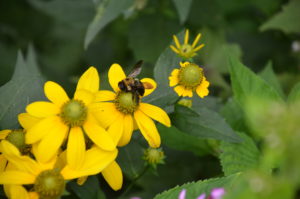Recently, the U.S. Fish and Wildlife Service recognized ten more animal species as Endangered Species, providing them protections under the Endangered Species Act of 1973. These 10 species include 7 species of bees. Endangered status will afford the rusty-patched bumblebee protection under federal law.
Bumblebees build their nests in the ground (and other places). Honeybees, however, who are not native to the U.S., build and live in their mostly above ground hive (nest) for many years. Populations of rusty-patched bumblebee were once widespread across the U.S. and Canada. Today, their greatest populations are found in the northeastern U.S. and Canada, and their numbers are spotty in several locales.
Bumble bees face many threats including loss of habitat, diseases, pesticide usage, and climate change. Unlike honeybees, which co-habitate in large colonies (>10,000 individuals) in perennial hives, bumble bees produce smaller annual populations (50-1,500 individuals). Due to their smaller annual population sizes, life cycle, and genetic makeup, they are a lot more susceptible to extinction.
Bumblebees typically nest underground, and overwinter in undisturbed ground – one that is not planted or mowed. Bumblebees frequently nest in compost piles, woodpiles, stone walls, or empty bird houses.
According to the Xerces Society, here are some things that gardeners can do to help bumblebees:
- Plant long flowering plants that start blooming early and finish late. Provide bumblebees with pollen and nectar from late winter through early autumn.
- Choose flowers of plant species native to your region that the bumblebees evolved alongside with. Plant species from around the world may be beneficial as well. Flowers should closely look like open pollinating species. Don’t plant varieties with double petals that make it hard for the bumblebee to access the pollen.
- Purple, blue and yellow flowers attract bumblebees. Bees cannot see the color red.
- Avoid using pesticides in your flower garden.
- Learn and understand the natural habitat of bumblebees
- Involve gardening friends and neighbors providing and conserving bee habitats.
For additional tips on conserving bumblebees, visit the Xerces Society website: http://www.xerces.org/bumblebees/


 Posted in
Posted in 
